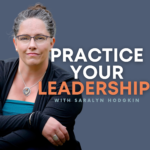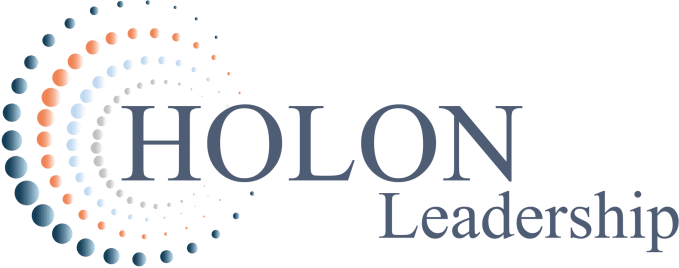Hi, everyone, I’m Saralyn Hodgkin. And this is the podcast to practice your leadership.
It’s okay to not be okay. I’ve heard that a few times in the last year and a half. And for some reason, in these days, it’s really hitting home for me, it is definitely okay to not be okay. Cataclysmic climate change, people coming in and out of COVID, oh my gosh, the list goes long, which we don’t need to belabor here. But I think what’s encouraged me to record this particular podcast is that when I’m talking to people about going back into work, or not going back into work, and the emotions that go with that, opening up our family, not opening up our family, and the emotions that go along with that, and so on, going to eat at a restaurant or not going into a restaurant, and so on, or the anticipation of schools opening in a couple of weeks.
I just felt really strongly to voice that it’s okay to not be okay. It’s okay to change your mind. Without super duper explanations. It is okay to say this isn’t okay for me right now. And then a week later say, well, it’s okay for me right now. There’s a McKinsey and Company article that came out a little bit ago about overcoming pandemic fatigue. And in it, they have, and I’ll list this in the resources, they have an image from 2000/2001, something like that from the US around supporting workers and major disasters or something along those lines, it’ll say in the source in the image. And it’s a great image because it shows the early days of crisis, how we come into this honeymoon period, the disillusionment that comes and we can’t keep up those heroic responses, and how then the energy just plummets, the grief kicks in.
And depending on how long, of course, these in this case, disasters happen, there are these anniversary periods, these trigger reactions, and these imaginings and dreaming ups of new normals, and then they don’t come to pass all at the same time. Looking at that in your workplace, and looking at that with your family looking at that with yourself, looking at that in community, however that is defined for you. And so it’s this wondering around how do we navigate what is actually complexity. And how Gregerson talks about these transition curves, which layer on the curves of trying to perform in these areas and learn in these areas all with, you know, in a COVID context anyways, all with the culture shock of new realities of us being open or not open and closed to not closed, you know, of course, with the other layer of a curve of grief, or for many trauma.
And so how do we perform and learn and navigate culture shock and process and acknowledge grief? Like it’s a lot, even when you’re really zipped up at home and you’re not on the front lines, it can be a lot, whatever your context is, it can be a lot. And so, for me, what came up and that I thought I’d share with you all here is what does it mean to actually practice that it’s okay to not be okay.
Like, okay, that’s a great saying, or I’ve heard we’re gonna rise stronger, or we’re gonna bounce back better or we’re gonna work through or whatever the statements are, and I get the rally cries, they’re important. But I thought okay, in our leadership in our agency, what is the actual practice? Like, what is it that I’m doing? To be able to say to friends of mine, actually, I’m not okay with your families come on over just yet. I know that here the rules are that you could I’m just not okay to have several families. Okay, what is it that I’m doing that allows me to say, that’s not okay for me right now. And so, for me, it came down to three things and three practices that I’m hoping are useful for you. The first one is around simply noticing my own signs.
What is it that I’m listening to? When do I need rest? What do I need to jump on my peloton and sweat it out? When do I need to find connection? When and how do I need to find that connection? And when do I need alone time, just with my family, just with myself, listening to my signs and taking pauses to be able to listen to those signs. For some of you that might be writing, journaling, drawing, walking, whatever it is, that is for you to be able to just pause and listen to your own signs. And listening to those signs is one thing, but it’s having a stance that goes along with that listening, a stance where, hey, it’s okay that I’m not okay with this, to hear that difference in my voice.
I’m going to stand here and listen to what I need and advocate for myself, just in this space. With me all alone, I’m going to have the courage to do that. And I’m going to think about how I take that note to the outer world. How I take that to my partner, to my workplace, to whoever I know. First, I’m going to pause and listen to myself and what I need. And I’m going to have a stance in myself to be able to receive that listening and advocate for it just within myself. Sometimes that’s just the work. So listening to my own signs and having that stance, you can even label that stance, right? You can power pose that stance, right, I’m going to have a stance of curiosity, I’m going to have a stance of self advocating, you can hear that, you know, that power in my voice, maybe it’s I have a stance of just being tender, whatever that is for you. Listen to the signs. Create your stance so that you can advocate for yourself with yourself.
And then the second thing for me is around boundaries. And this is something that I touch on all the time. In my own practice and when I talk to people, it’s a big conversation right now I always turn to when I’m unsure of things, around what are boundaries, what does that mean? I turn to Brene Browns’s anatomy of trust, where she operationalizes trust, those are my words, not necessarily hers, but with boundaries she talks about, and these are her words, hey, you can respect my boundaries and when you’re not clear about what’s okay and not okay, you can ask and you’re willing to say no.
And to bring that into my own personal practice that I am clear about what’s okay and not okay, I make a list of at this time what’s okay and not okay. And so part of my practice is saying to myself, after I listen, in the stance that I’m choosing to advocate for myself with myself, then I create a list of what is okay and not okay. And with that, I adapt it. It’s flexible. It’s not set in stone, if that changes tomorrow it changes tomorrow, and that’s just fine. It evolves and sometimes what can be really helpful with that, as well is creating these statements.
And Nedra Glover Tawwab, has also written a great book around boundaries, just published this year in 2021. On her Instagram, if I’m not mistaken, she has some posts around like, what do boundaries look like? What do they sound like, you know, I’m resting to prevent burnout. There’s a boundary statement done. I’m choosing not to go into work until I see X, Y and Z boundary. I’ll ask for help before I’m overwhelmed – boundary statement.
What are some of the places in your practice that needs some of these boundary statements that need you to put attention into what’s okay and not okay? And actually write down those statements and then practice communicating those statements using those statements. And then lastly, this is a big one all on its own, building my own resiliency toolkit that includes having moments of grief. That includes having to have practices and intentional moments of letting some things go. And some of the systems training that I’ve done, it’s about just recognizing your disappointed dream and letting that go.
So grieving that. And then in that resiliency toolkit, what are the practices that I need to be able to surf the waves of adaptability, one of the practices that I need to be able to integrate what I’m learning and what’s okay and not okay for me right now. Building that resiliency toolkit in a way that allows me to have perspective and gratitude and practices that for me right now allow me to stand on those boundary statements that allow me to listen to my signs of what I need and allow me to cultivate practices that say, this is what resiliency looks for you right now, Saralyn.
So, standing back, it’s okay to not be okay. And to take that into practice, listen to your signs, create your boundaries, build that resiliency toolkit for yourself. Keep going with the practice.
Thanks. I’m Saralyn You can find me at holonleadership.org. I walk alongside you as you practice your leadership.


 Apple Podcasts
Apple Podcasts Spotify
Spotify Google Podcasts
Google Podcasts